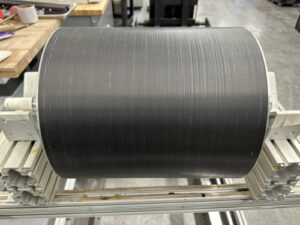“The ASCEND program sets a benchmark of the fully integrated all-electric powertrain system at a power density of ≥ 12 kW/kg with an efficiency at ≥ 93%. Currently, these targets, among others, are beyond the capability of state-of-the-art technologies and will require creative thinking and innovation in the electric motor and power electronics space.” As shown below, the large Wright motors will be available in both ducted fan jet and turboprop configurations.
Wright Electric, one of eleven organizations signed up for the ASCEND Program, is pushing forward on several projects encompassing the totality of electric propulsion.
WM2500 Motor
Jeffrey Engler started Wright Electric in 2018, with assistance from Yates Aerospace, a firm headed by record-holder Chip Yates. According to Wikipedia, “Two test stands were constructed: one with two 250 [kilowatt] (335 horsepower) UQM motors and two Hartzell Propellers,… the other on a 10,000 [pound] (4,500[kilogram]) trailer to be brought to high altitude test sites.” Yates had used the same UQM motor on his record-setting 201 mph electric bike and his Rutan LongEze, so was very familiar with its characteristics.
Engler’s firm has leapfrogged FROM those early tests to achieve one of the most powerful and power dense electric aircraft motors “under development.” The WM2500, designed for the 100+ passenger market, could be a significant factor in reducing or eliminating up to 95 percent of aviation’s carbon emissions.
The motor, like almost all electric powerplants, consists of a stator (the stationary part of the motor) and a rotor (the part that rotates). Wright has completed the rotor of what should be a 16 kilowatt per kilogram motor, the highest power density from any maker so far.

The rotor for the WM2500
Emrax, for instance, a Slovenian maker of smaller motors claims a power density of up to 10 kW/kg. Germany’s Eck-Geiger Engineering claims up to 4.375 kW/kg for its light aircraft motors. At a larger scale, ZeroAvia pulls 900 kW (1,206 horsepower) peak from 93 kg (204.6 pounds), or 9.677 kW per kg.
Smaller ZeroAvia power systems show 93 kilograms producing up to 900 kW peak for the motors alone. Another weight shown in company documentation, 153 kilograms (336.6 pounds) may include additional components, but your editor hopes to delve further.
Batteries Too
Wright is also developing high-energy-density batteries which will rival all the similar efforts from several manufacturers now being released. These batteries come in both air and marine configurations and are claimed to provide four times the energy density of currently available cells.
Wright’s crew has assembled a testing unit, which will put the various components and full motor systems through their paces. Following successful tests, the systems will be sent to NASA’s NEAT (NASA Electric Testbed) site at the NASA’s Neil A. Armstrong Test Facility in Sandusky, Ohio.
The company announced, “Our testing unit is currently being assembled, so we are bringing a line-for-line outer mold line prototype. We’re also bringing the ducted fan that converts WM2500’s torque into thrust, as well as the nacelle inlet that will be used during performance testing. A few weeks ago, Wright announced that we’re beginning propulsion testing of our family of Electric Aircraft Engines and we’ll be using pieces from this demonstration in our test cell.”
Beyond components, Wright is working toward providing a complete WM2500 system to be run at their own test facility.
And Even Generators
Wright’s generators, designed for military use, but doubtless capable of pulling civilian duty, are claimed to be half the weight of their commercial counterparts, important in hauling otherwise heavy gear to distant locales.
A Competitive, Bright Future
Jeffrey Engler certainly has the Wright stuff, and leads a company that didn’t exist eight years ago into a dynamic role in crafting near-future realization of green flight.

